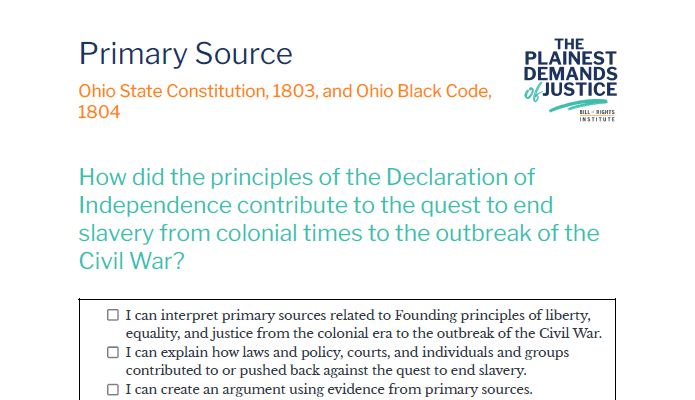Ohio State Constitution, 1803 and Black Code, 1804
How did the principles of the Declaration of Independence contribute to the quest to end slavery from colonial times to the outbreak of the Civil War?
- I can interpret primary sources related to Founding principles of liberty, equality, and justice from the colonial era to the outbreak of the Civil War.
- I can explain how laws and policy, courts, and individuals and groups contributed to or pushed back against the quest to end slavery.
- I can create an argument using evidence from primary sources.
- I can analyze issues in history to help find solutions to present-day challenges.
Building Context
Despite Founding affirmations of equality, many states placed restrictions on the lives of free African Americans. These restrictions took the form of laws referred to throughout American history as Black Codes. Black Codes were meant to keep free African Americans in the role of second-class citizens.
Ohio State Constitution, 1803
Source: https://ohiohistorycentral.org/w/Ohio_Constitution_of_1803_(Transcript)#ARTICLE_VIII._BILL_OF_RIGHTS
Article VIII, sec 2. There shall be neither slavery nor involuntary servitude in this State, otherwise than for the punishment of crimes, whereof the party shall have been duly convicted; nor shall any male person, arrived at the age of twenty-one years, or female person arrived at the age of eighteen years, be held to serve any person as a servant, under the pretense of indenture or otherwise, unless such person shall enter into such indenture while in a state of perfect freedom…
Ohio Black Code, 1804
Source link: https://ohiohistorycentral.org/w/Ohio_Constitution_of_1803_(Transcript)#ARTICLE_VIII._BILL_OF_RIGHTS
Section 1. Be it enacted by the General Assembly of the State of Ohio , That from and after the first day of June next. no black or mulatto person shall be permitted to settle or reside in this state, unless he or she shall first produce a fair certificate from some court within the United States, of his or her actual freedom, which certificate shall be attested by the clerk of said court, and the seal thereof annexed thereto, by said clerk. . .
Sec. 3. And be it further enacted, That no person or persons residents of this state, shall be permitted to hire, or in any way employ any black or mulatto person, unless such black or mulatto person shall have one of the certificates as aforesaid, under pain of forfeiting and paying any sum not less than ten nor more than fifty dollars, at the discretion of the court. . .
Comprehension and Analysis Questions
- How are these documents inconsistent with each other?
- How did the Black Codes in the second document restrict the lives of free African Americans?
